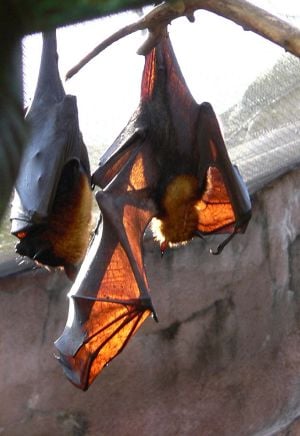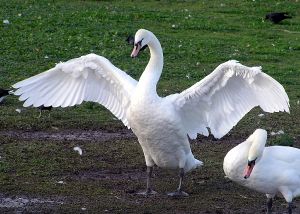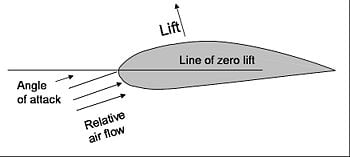Wing
A wing is a natural or artificial surface used to produce lift and therefore flight, for travel in the air or another gaseous medium. The first use of the word was for the foremost limbs of birds, but has been extended to include the wings of insects, bats, and pterosaurs, as well as human-made devices.
The wing shape is usually an airfoil. An airfoil-shaped body moved through a fluid produces a force perpendicular to the motion, called lift.

Human creativity, inspired by the wonder of flight seen in nature, has been reflected in the development of artificial wings, as seen in airplanes and gliders. Furthermore, wings in nature also have added immeasurably to human joy, whether the elaborate colors and patterns of butterfly wings, or the sound production utilizing wings in crickets and grasshoppers, or the acrobat twisting and turning of bats, and the soaring of eagles—all adding to the beauty and wonder of nature for people.
Overview
A wing is a device for generating lift. Lift is a mechanical force generated by solid objects as they move through a fluid. Technically, lift is the sum of all the fluid dynamic forces on a body perpendicular to the direction of the external flow approaching that body. Lift is generated when an object turns a fluid away from its direction of flow. When the object and fluid move relative to each other, the object turns the fluid flow in a direction perpendicular to that flow, and the force required to do this creates an equal and opposite force that is lift. The object may be moving through a stationary fluid, or the fluid may be flowing past a stationary object—these two are effectively identical as, in principle, it is only the frame of reference of the viewer which differs. In the case of an aircraft wing, pressure regions turn the passing flow of air downward towards the ground. These pressure regions exert an equal and opposite force on the wing, called lift, that supports the aircraft in the air.
The lift generated by an airfoil depends on such factors as the speed of the airflow, the density of the air, the total area of the airfoil, and the angle of attack. The angle of attack is the angle at which the airfoil meets the oncoming airflow (or vice versa). A symmetric airfoil must have a positive angle of attack to generate positive lift. At a zero angle of attack, no lift is generated. At a negative angle of attack, negative lift is generated. A cambered airfoil may produce positive lift at zero, or even small negative angles of attack.
A wing's aerodynamic quality, expressed as a lift-to-drag ratio, can be up to 60 on some gliders. This means that a significantly smaller thrust force can be applied to propel the wing through the air in order to obtain a specified lift.
A common use of wings is in flight, using forward motion to create vertical lift, but wings are also used to produce downforce holding racing cars on the ground. A sail boat moves by using sails and a keel like a vertical wings to produce lift (in the horizontal plane).
Structures with the same purpose as wings, but designed to operate in liquid media, are generally called fins or hydroplanes, with hydrodynamics as the governing science. Applications arise in craft such as hydrofoils and submarines.
Science of wings
The science of wings is one of the principal applications of the science of aerodynamics.
In order for a wing to produce lift, it has to be at a positive angle to the airflow. In that case, a low pressure region is generated on the upper surface of the wing, which draws the air above the wing downwards towards what would otherwise be a void after the wing had passed. On the underside of the wing, a high pressure region forms accelerating the air there downwards out of the path of the oncoming wing. The pressure difference between these two regions produces an upwards force on the wing, in other words, lift.
The pressure differences, the acceleration of the air, and the lift on the wing are intrinsically one mechanism. It is therefore possible to derive the value of one by calculating another. For example, lift can be calculated by reference to the pressure differences or by calculating the energy used to accelerate the air. Both approaches will result in the same answer if done correctly. Debates over which mathematical approach is the more convenient can be wrongly perceived as differences of opinion about the principles of flight and often create unnecessary confusion in the mind of the layman.
A common misconception is that it is the shape of the wing that is essential to generate lift by having a longer path on the top rather than the underside. This is not the case, thin flat wings can produce lift efficiently, and aircraft with cambered wings can fly inverted, as long as the nose of the aircraft is pointed high enough so as to present the wing at a positive angle of attack to the airflow.
The common aerofoil shape of wings is due to a large number of factors, many of them not at all related to aerodynamic issues; for example, airplane wings need strength and, thus, need to be thick enough to contain structural members. They also need room to contain items such as fuel, control mechanisms, and retracted undercarriage. The primary aerodynamic input to the wing’s cross sectional shape is the need to keep the air flowing smoothly over the entire surface for the most efficient operation. In particular, there is a requirement to prevent the low-pressure gradient that accelerates the air down the back of the wing becoming too great and effectively “sucking” the air off the surface of the wing. If this happens, the wing surface from that point backwards becomes substantially ineffective.
The shape chosen by the designer is a compromise dependent upon the intended operational ranges of airspeed, angles of attack, and wing loadings. Usually, aircraft wings have devices, such as flaps, which allow the pilot to modify shape and surface area of the wing to be able to change its operating characteristics in flight.
The science of wings applies in other areas beyond conventional fixed-wing aircraft, including:
- Helicopters which use a rotating wing with a variable pitch or angle to provide a directional force
- The space shuttle, which uses its wings only for lift during its descent
- Some racing cars, especially Formula One cars, which use upside-down wings to give cars greater adhesion at high speeds over 100 miles per hour.
- Sailing boats, which use sails as vertical wings with variable fullness and direction to move across water.
Animal wings

Biologists believe that animal wings evolved at least four separate times, an example of convergent evolution.
- Insect wings are believed to have evolved between 300 and 400 million years ago
- Pterosaur wings at least 225 million years ago
- Bird wings at least 150 million years ago
- Bat wings about 55 million years ago.
Wings in these groups are analogous structures because they arose independently rather than being passed from a common ancestor.
Bird wings
The bird's forelimbs, the wings, are the key to bird flight. Each wing has a central vane to hit the wind, composed of three limb bones, the humerus, ulna, and radius. The hand, or manus, which ancestrally is believed to have been composed of five digits, is reduced to three digits (digit II, III, and IV), the purpose of which is to serve as an anchor for the primaries (or metacarpo-digitals), one of two groups of feathers responsible for the airfoil shape. The other set of flight feathers that are behind the carpal joint on the ulna are called the secondaries or cubitals. The remaining feathers on the wing are known as coverts, of which there are three sets.
The wing sometimes has vestigial claws, but in most species these are lost by the time the bird is adult (such as the highly visible ones used for active climbing by Hoatzin chicks). Claws are retained into adulthood by the secretary bird, the screamers, finfoot, ostriches, and several swifts, as well as numerous others, as a local trait, in a few specimens. The claws of the Jurassic therapod-like archaeopteryx are quite similar to those of the hoatzin nestlings.
Basic mechanics of bird flight
The fundamentals of bird flight are similar to those of aircraft. Lift force is produced by the action of air flow on the wing, which is an airfoil.
When gliding, both birds and gliders obtain both a vertical and a forward force from their wings. This is possible because the lift force is generated at right angles to the air flow, which in level flight comes from slightly below the wing. The lift force therefore has a forward component. (Weight always acts vertically downwards and so cannot provide a forward force. Without a forward component, a gliding bird would merely descend vertically, exactly as a parachute does).
When a bird flaps, as opposed to gliding, its wings continue to develop lift as before, but they also create an additional forward and upward force, thrust, to counteract its weight and drag. Flapping involves two stages: The down-stroke, which provides the majority of the thrust, and the up-stroke, which can also (depending on the bird's wings) provide some upward force. At each up-stroke, the wing is slightly folded inwards to reduce upward resistance. Birds change the angle of attack between the up-stroke and the down-stroke of their wings. During the down-stroke the angle of attack is increased, and is decreased during the up-stroke.
There are three major forces that impede a bird's aerial flight: Frictional drag (caused by the friction of air and body surfaces), form drag (due to frontal area of the bird, also known as pressure drag), and lift-induced drag (caused by the wingtip vortices).
Insect wings


Insect wings are outgrowths of the insect exoskeleton. They are found on the second and third thoracic segments (the mesothorax and metathorax), and the two pairs are often referred to as the forewings and hindwings, respectively, though a few winged insects lack hindwings, even rudiments. Insect wings do not constitute "appendages" in technical parlance, as insect only have one pair of appendages per body segment. The wings are strengthened by a number of longitudinal veins, which often have cross-connections that form closed "cells" in the membrane (extreme examples include Odonata and Neuroptera). The patterns resulting from the fusion and cross-connection of the wing veins are often diagnostic for different evolutionary lineages and can be used for identification to the family or even genus level in many orders of insects.
Fully functional wings are present only in the adult stage, after the last molt. The one exception is the order Ephemeroptera, in which the penultimate instar (also called the subimago) possesses well-developed and functional wings, which are shed at the final molt. Wings are only present in the subclass Pterygota, with members of the archaic Apterygota being wingless. Wings may also be lost in some pterygote clades, such as the fleas and lice.
The wings may be present in only one sex (often the male) in some groups, such as velvet ants and Strepsiptera, or selectively lost in "workers" of social insects, such as ants and termites. Rarely, the female is winged but the male is not, as in fig wasps. In some cases, wings are produced only at particular times in the life cycle, such as in the dispersal phase of aphids. Beyond the mere presence/absence of wings, the structure and coloration will often vary with morphs, such as in the aphids, migratory phases of locusts, and in polymorphic butterflies.
At rest, the wings may be held flat, or folded a number of times along specific patterns; most typically, it is the hindwings that are folded, but in a very few groups such as vespid wasps, it is the forewings.
Insect flight can be extremely fast, maneuverable, and versatile. This flight is possible due to the changing shape, extraordinary control, and variable motion of the insect wing. Insect orders use different flight mechanisms, for example, the flight of a butterfly can be explained using steady-state, non-transitory aerodynamics and thin aerofoil theory.
Two main theories on the origins of insect flight are that wings developed from paranotal lobes, extensions of the thoracic terga, and that they are modifications of movable abdominal gills, as found on aquatic naiads of mayflies (Grimaldi and Engel 2005).
Structure of insect wings
Veins. A hypothetical primitive wing venation pattern is often used as a basis for describing the pattern in extant forms. This primitive archetype is termed the archedictyon.
The veins are hollow structures formed from the coupling of the upper and lower walls of the wing. The bigger ones may contain nerves, tracheae, and hemolymph. The smaller ones can be mainly chitinous rigidifying structures. The pattern is extremely variable and can be very useful for identification.
The veins provide both rigidity and flexibility enabling the use of the insect wings for flight. Most importantly, the wing membrane between the veins is commonly corrugated, distorted, or angled (or "pleated") in order to give further strength to the wing, as well as changing the effective cross-section of the wing from a flat sheet into something more closely approximating an airfoil.
Cells. The cells are spaces formed by the cross-connecting of the veins. They can be "open" (extending to the margin of the wing) or "closed" (delimited only by veins).
The veins and cells are named after the Comstock-Needham system (1898).
Adaptations of insect wings
Several orders of insects have specially-adapted wings.
For orientation
- In the Diptera (true flies), the posterior pair of wings are reduced to halteres, which help the fly to sense its orientation and movement, as well as to improve balance by acting similar to gyroscopes.
- In the Strepsiptera, it is the anterior wings of the males that are reduced to form halteres. The females are wingless.
For protection

- In Coleoptera (beetles), the front pair of wings are sclerotised (hardened) to form elytra, and they protect the delicate hindwings, which are folded beneath.
- In Hemiptera (true bugs), the forewings may be hardened, though to a lesser extent than in the beetles. For example, the anterior part of the front wings of stink bugs is hardened, while the posterior part is membranous. They are called hemelytron (pl. hemelytra). They are only found in the suborder Heteroptera; the wings of the Homoptera, such as the cicada, are typically entirely membranous.
- Other orders such as the Dermaptera (earwigs), Orthoptera (grasshoppers, crickets), Mantodea (praying mantis), and Blattodea (cockroaches) have rigid leathery forewings that are not used for flying, sometimes called tegmen (pl. tegmina), elytra, or pseudoelytron.
- In a number of other orders, the forewings may occasionally be modified for protection, and this usually occurs in conjunction with the loss or reduction of the hindwings (for example, in flightless insects). Similarly, flightless members of the preceding orders often entirely lack hindwings.
Other adaptations
- Some orders may use their wings for communication. For example, the elaborate colors on butterfly wings are sometimes a warning for predators (aposematism), as is the case in toxic species such as the monarch butterfly. Many insects can see in the ultraviolet range of light and some species have UV reflective patches on their wing, which act as indicators of fitness used in mate selection.
- In the Dipteran subsection Calyptratae, the very hindmost portion of the wings are modified into somewhat thickened flaps called calypters which cover the halteres.
- In a number of Diptera, especially in the superfamily Tephritoidea (various "picture-winged" flies), the wings are used in elaborate courtship displays by the males, though not in flight; the wings are lifted, flipped, and rotated in various ways (often left and right independently) while the male walks or dances near the female he is courting.
- Males in a few groups of Lepidoptera have specially-modified sets of wing scales that are associated with pheromone glands in the wings themselves, and structured in such a way as to facilitate the evaporation and dispersal of the pheromones. Perhaps the most well-known species of this type is the monarch butterfly, in which the modified scales form a small black bulge along one of the hindwing veins.
- In the Mecoptera, males of the family Boreidae ("snow scorpionflies") have the wings reduced to bristles, which they use to help grasp the females during mating.
- In the order Orthoptera, wings are modified to help in sound production. In the Ensifera, this is achieved by rubbing the edges of the wings, which have minute rasp like structures, against each other while the hind femora are rubbed against the wings in the Caelifera (see also stridulation). In a few grasshoppers, the sound-producing structures function only when the wings are flapping, with the forewings and hindwings hitting one another, and in some Lepidoptera (for example, Cracker butterflies), sound is produced by the forewings striking one another at the peak of the upstroke.
- Aquatic beetles, such as the diving beetle Dytiscus, use the space between the elytra and the abdomen to hold air.
- Some species use the wings for thermoregulation. Many alpine butterflies have black patches on their wing that help absorb solar radiation and thermoregulate by changing the posture of the wings.
- Some species of Tenebrionid beetles in the Namib desert have elytra, which act as surfaces for fog to condense and have a ridge to divert the water towards their mouth.
Artificial wings
Design features
Airplane wings may feature some of the following:
- A rounded (rarely sharp) leading edge cross-section
- A sharp trailing edge cross-section
- Leading-edge devices such as slats, slots, or extensions
- Trailing-edge devices such as flaps
- Ailerons (usually near the wingtips) to provide roll control
- Spoilers on the upper surface to disrupt lift and additional roll control
- Vortex generators to help prevent flow separation
- Wing fences to keep flow attached to the wing
- Dihedral, or a positive wing angle to the horizontal. This gives inherent stability in roll. Anhedral, or a negative wing angle to the horizontal, has a destabilizing effect
- Folding wings allow more aircraft to be carried in the confined space of the hangar of an aircraft carrier.
Wing types
- Swept wings are wings that are bent back at an angle, instead of sticking straight out from the fuselage.
- Forward-swept wings are bent forward, the reverse of a traditional swept wing. Forward swept wings have been used in some two seat gliders, and in the experimental X-29.
- Elliptical wings (technically wings with an elliptical lift distribution) are theoretically optimum for efficiency at subsonic speeds. A good example of this wing type can be seen on the British Supermarine Spitfire World War II fighter aircraft.
- Delta wings have reasonable performance at subsonic and supersonic speeds and are good at high angles of attack. For examples see the F-102, F-106, Avro Vulcan, and B-58.
- Waveriders are efficient supersonic wings that take advantage of shock waves. For an example, in the XB-70.
- Rogallo wings are two partial cone sections arranged with the apexes together and the convex side up. One of the simplest wings to construct using cloth or other membrane material and a frame.
- Swing-wings (or variable geometry wings) are able to move in flight to give the benefits of dihedral and delta wing. Although they were originally proposed by German aerodynamicists during the 1940s, they are now only found on military aircraft such as the Grumman F-14, Panavia Tornado, General Dynamics F-111, B-1 Lancer, Tupolev Tu-160, MiG-23, and Sukhoi Su-24.
- Ring wings are optimally loaded closed lifting surfaces with higher aerodynamic efficiency than planar wings having the same aspect-ratios. Other nonplanar wing systems display an aerodynamic efficiency intermediate between ring wings and planar wings.
- Oblique wing
- Flying wing
- Blended wing body
ReferencesISBN links support NWE through referral fees
- Anderson, J. 2004. Introduction to Flight. New York: McGraw-Hill. ISBN 0071238182
- Grimaldi, D. and M. S. Engel. 2005. Evolution of the Insects. New York: Cambridge University. ISBN 0521821495
- Triplehorn, C. A. and N. F. Johnson Norman. 2005. Borror and DeLong's Introduction to the Study of Insects. Thomson Brooks/Cole. ISBN 0030968356
Credits
New World Encyclopedia writers and editors rewrote and completed the Wikipedia article in accordance with New World Encyclopedia standards. This article abides by terms of the Creative Commons CC-by-sa 3.0 License (CC-by-sa), which may be used and disseminated with proper attribution. Credit is due under the terms of this license that can reference both the New World Encyclopedia contributors and the selfless volunteer contributors of the Wikimedia Foundation. To cite this article click here for a list of acceptable citing formats.The history of earlier contributions by wikipedians is accessible to researchers here:
The history of this article since it was imported to New World Encyclopedia:
Note: Some restrictions may apply to use of individual images which are separately licensed.




